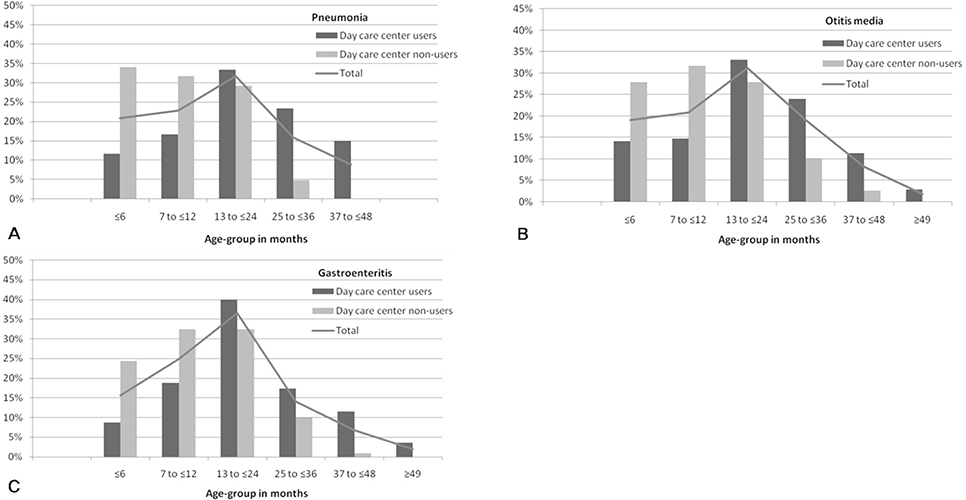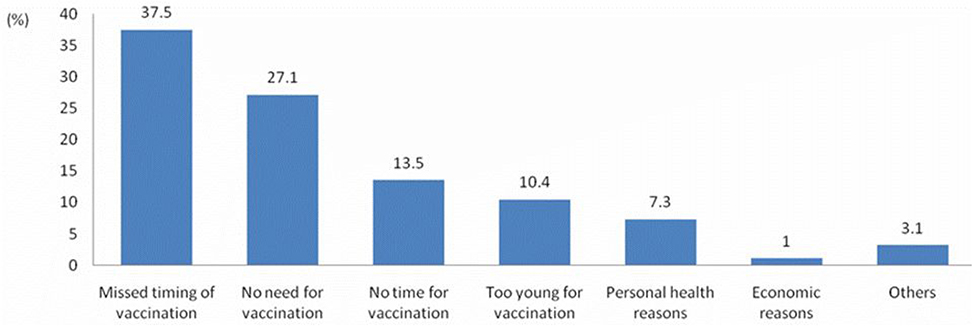Korean J Pediatr Infect Dis.
2012 Apr;19(1):19-27.
A Nationwide Survey on the Child Day Care and Common Infectious Diseases
- Affiliations
-
- 1Department of Pediatrics, Severance Children's Hospital, Yonsei University College of Medicine, Seoul, Korea. khkim99@yuhs.ac
Abstract
- PURPOSE
As the number of children who attend child care centers has increased, concerns has increased about the effect of child day care on childhood illness. This study was conducted to examine the relationship between experience in child care and common infectious diseases in children under 5 years of age.
METHODS
Data were collected by surveying 1,000 respondents with children under age 5 through online interviews using a structured questionnaire. The contents of the survey were composed of demographic characteristics, child care facilities usage, experience in infectious diseases, and immunization status.
RESULTS
Among the 1,000 children <5 years of age, 78.5% attended a child care facility. Rates of common communicable illnesses were higher in children in child care than for children reared exclusively at home. The predominant communicable diseases which the respondents' children experienced, in order of decreasing frequency, were gastroenteritis (47.1%), otitis media (41.8%) and pneumonia (19.1%). The immunization rate of vaccines that are not included the national immunization program (NIP) (Haemophilus influenzae type b vaccine - 76.6%, hepatitis A vaccine - 63.3%, pneumococcal vaccine - 59.4%, rotavirus vaccine - 43.1%) was lower than that of the NIP vaccines (90.4%).
CONCLUSION
Children in child care experience more bouts of common infectious disease, so nationwide policies to prevent or to control the spread of infectious agents in a child-care should be available and appropriate immunization should be emphasized as the most effective method for the control of infectious disease for children.
Keyword
MeSH Terms
Figure
Reference
-
1. National research council for economics. humanities and social sciences. Korea institute of child care and education. The main statistics on childhood education and child care. 2011. Seoul:2. Alho O, Läärä E, Oja H. Public health impact of various risk factors for acute otitis media in northern Finland. Am J Epidemiol. 1996. 143:1149–1156.
Article3. Alexander C, Zinzeleta E, MacKenzie E, Vernon A, Markowitz R. Acute gastrointestinal illness and child care arrangements. Am J Epidemiol. 1990. 131:124–131.
Article4. Paradise J, Rockette H, Colborn K, Bernard BS, Smith CG, Kurs-Lasky M, et al. Otitis media in 2253 Pittsburgh-area infants: prevalence and risk factors during the first two years of life. Pediatrics. 1997. 99:318–333.
Article5. Johansen A, Leibowitz A, Waite L. Child care and children's illness. Am J Public Health. 1988. 78:1175–1177.
Article6. Hardy A, Fowler M. Child care arrangements and repeated ear infections in young children. Am J Public Health. 1993. 83:1321–1325.
Article7. Hurwitz E, Gunn W, Pinsky P, Shonberger L. Risk of respiratory illness associated with day-care attendance: a nationwide study. Pediatrics. 1991. 87:62–69.
Article8. Louhiala P, Jaakkola N, Ruotsalainen R, Jaakkola J. Form of day care and respiratory infections among Finnish children. Am J Public Health. 1995. 85:1109–1112.
Article9. Petersson C, Håkansson A. A retrospective study of respiratory tract infections among children in different forms of day care. Scand J Prim Health Care. 1990. 8:119–112.
Article10. Louhiala P, Jaakkola N, Ruotsalainen R, Jaakkola J. Day-care centers and diarrhea: a public health perspective. J Pediatr. 1997. 131:476–479.
Article11. Marx J, Osguthorpe JD, Parsons G. Day care and the incidence of otitis media in young children. Otolaryngol Head Neck Surg. 1995. 112:695–699.
Article12. Ponka A, Nurmi R, Salminen E, Nykyri E. Infections and other illnesses in daycare centers in Helsinki, I: incidences and effects of home and day-care center variables. Infection. 1991. 19:230–236.
Article13. Rasmussen F. Protracted secretory otitis media. the impact of familial factors and day-care center attendance. Int J Pediatr Otorhinolaryngol. 1993. 26:29–37.
Article14. National Institute of Child Health and Human Development Early Child Care Research Network. Child care and common communicable illnesses: results from the National Institute of Child Health and Human Development Study of Early Child Care. Arch Pediatr Adolesc Med. 2001. 155:481–488.15. Reves RR, Morrow AL, Bartlett AV 3rd, Caruso CJ, Plumb RL, Lu BT, et al. Child day care increases the risk of clinic visits for acute diarrhea and diarrhea due to rotavirus. Am J Epidemiol. 1993. 137:97–107.
Article16. Arnold C, Makintube S, Istre G. Day care attendance and other risk factors for invasive Haemophilus influenza type b disease. Am J Epidemiol. 1993. 138:333–340.
Article17. Dagan R, Sikuler-Cohen M, Zamir O, Janco J, Givon-Lavi N, Fraser D. Effect of a conjugate pneumococcal vaccine on the occurrence of respiratory infections and antibiotic use in day-care center attendees. Pediatr Infect Dis J. 2001. 20:951–958.
Article18. Kim EJ, Kwon YR, Song KH, Jang WN, Lee J, Chang JK, et al. A study on risk factors of recurrent otitis media. Korean J Pediatr Infec Dis. 2010. 17:91–100.
Article19. Linda A, Waggoner-Fountain . Kliegman RM, Behrman RE, Jenson HB, Stanton BF, editors. Child care and communicable diseases. Nelson Textbook of Pediatrics. 2007. 18th ed. Philadelphia: WB Saunders;1074–1077.20. Pickering LK, Baker CJ, Kimberlin DW, editors. Children in out-of-home child care. Red book: 2009 Report of the committee on infectious diseases. 2009. 28th ed. Elk Grove Village, IL: American Academy of Pediatrics;128–129.21. Wald ER. Feigin RD, Cherry JD, Demmler-Harrison GJ, Kaplan SL, editors. Infections in day care environments. Textbook of pediatric infectious diseases. 2009. 6th ed. Philadelphia: WB Saunders;3480–3496.22. Kim JS. Effects of a training program on infection prevention for staff of child daycare centers. J Korean Acad Child Health Nurs. 2007. 13:467–477.23. Park SN, Lee YR, Joung YJ, Kim KM. Knowledge and management of children with infectious diseases by daycare facility teachers. J Korean Acad Public Health Nurs. 2010. 24:115–125.24. Hinman AR. Vaccine-preventable diseases and child day care. Rev Infect Dis. 1986. 8:573–583.
Article
- Full Text Links
- Actions
-
Cited
- CITED
-
- Close
- Share
- Similar articles
-
- Needs of Day-care Staff for a Center-based Child Care Health Program II
- Infection in Children Attending Day Care Centers
- A Survey on the Use of Visiting Nurses in Child Day Care Centers
- The prevention and response to infectious diseases in long-term care facilities in Korea: a nationwide survey
- Health Problems and Health Services in Child Day Care Centers




